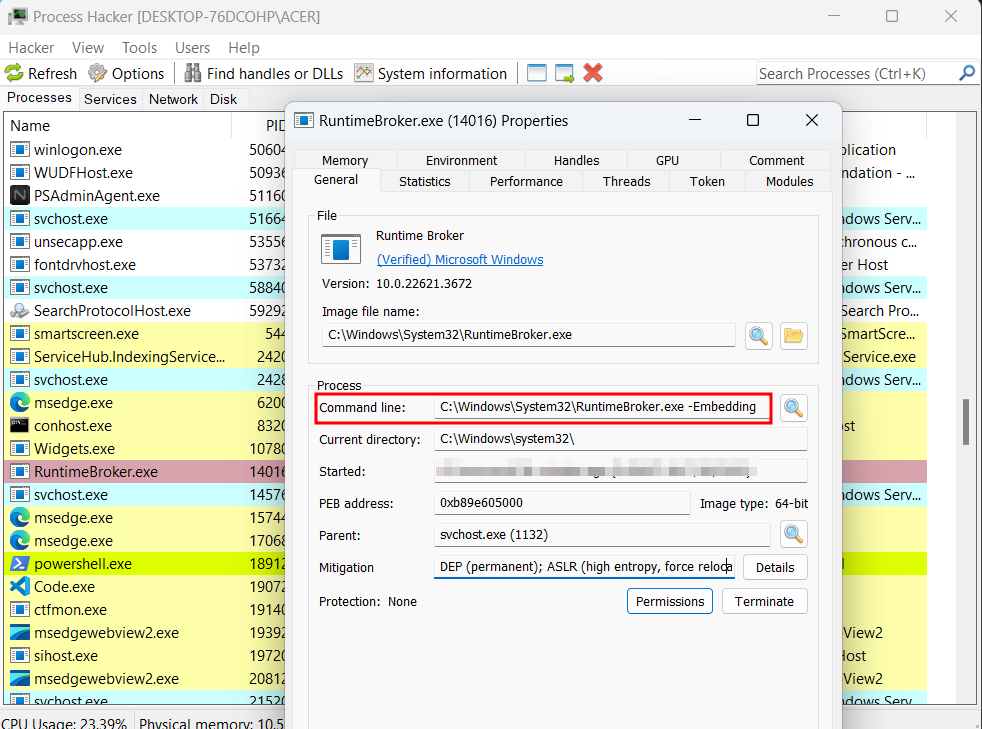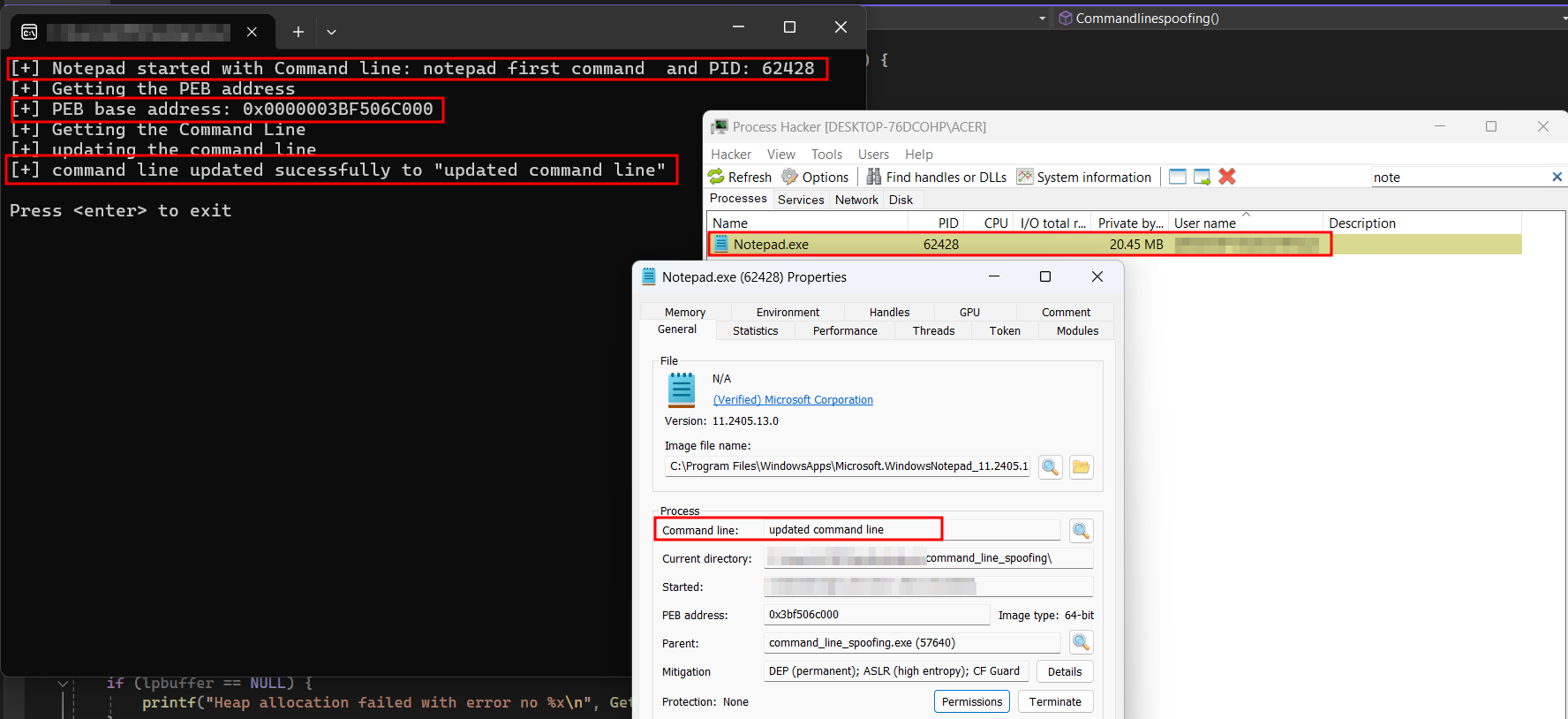Command Line Spoofing
Command line spoofing is a technique where the instructions given to a program through the command line are altered or replaced. To make this clearer, let’s break it down:
When a program runs, it often needs specific details or instructions to work correctly. These instructions are provided through the command line a way to type in commands and arguments that the operating system uses to run the program. For example, you might use command line arguments to tell a program which files to open or what actions to perform.
As can be seen in the screenshot below, the command line interface displays these arguments.
Command line spoofing happens when these instructions are changed or manipulated, leading the program to perform actions it wasn’t originally intended to. This can cause the program to behave differently or produce unexpected results.
Before Starting
To change the command line of a process, we first need to know about Process Environment Block (PEB).
The Process Environment Block (PEB) is a data structure that holds important information about a process. It includes details such as:
- Whether the program is being debugged
- Loaded modules
- Process parameters, and more
Since the PEB is located in user space, it can be accessed relatively easily. The structure of the PEB looks like this:
1
2
3
4
5
6
7
8
9
10
11
12
13
14
15
16
17
18
19
20
21
22
typedef struct _PEB {
BYTE Reserved1[2];
BYTE BeingDebugged;
BYTE Reserved2[1];
PVOID Reserved3[2];
PPEB_LDR_DATA Ldr;
PRTL_USER_PROCESS_PARAMETERS ProcessParameters;
PVOID Reserved4[3];
PVOID AtlThunkSListPtr;
PVOID Reserved5;
ULONG Reserved6;
PVOID Reserved7;
ULONG Reserved8;
ULONG AtlThunkSListPtr32;
PVOID Reserved9[45];
BYTE Reserved10[96];
PPS_POST_PROCESS_INIT_ROUTINE PostProcessInitRoutine;
BYTE Reserved11[128];
PVOID Reserved12[1];
ULONG SessionId;
} PEB, *PPEB;
In the PEB structure, the ProcessParameters field refers to the PRTL_USER_PROCESS_PARAMETERS structure which is our main focus because it contains the command line information of the process. To understand why this is important for spoofing the command line, let’s take a look at the structure:
1
2
3
4
5
6
7
8
typedef struct _RTL_USER_PROCESS_PARAMETERS {
BYTE Reserved1[16];
PVOID Reserved2[10];
UNICODE_STRING ImagePathName;
UNICODE_STRING CommandLine;
} RTL_USER_PROCESS_PARAMETERS, *PRTL_USER_PROCESS_PARAMETERS;
The PRTL_USER_PROCESS_PARAMETERS structure includes a CommandLine field, which is a UNICODE_STRING structure. This field contains the actual command line arguments used by the process. To understand how to modify the command line, we need to take a closer look at the UNICODE_STRING structure.
1
2
3
4
5
typedef struct _UNICODE_STRING {
USHORT Length;
USHORT MaximumLength;
PWSTR Buffer;
} UNICODE_STRING, *PUNICODE_STRING;
The UNICODE_STRING structure includes a Buffer field, which points to the actual command line arguments for the process. This Buffer contains the location where the command line string is stored.
If we can overwrite the data at the location pointed to by the Buffer, we should be able to change the command line arguments of the process.
Technique
To change the command line of a process, we first need to find the address of the PEB (Process Environment Block). Here’s how we can do it:
- Retrieve the
PEBAddress:- Use the
NtQueryInformationProcessfunction with theProcessBasicInformationvalue for theProcessInformationClassparameter. This function provides aPROCESS_BASIC_INFORMATIONstructure. - The
PROCESS_BASIC_INFORMATIONstructure contains the address of thePEB.
- Use the
- Access the
PEBStructure:- Once we have the
PEBaddress from thePROCESS_BASIC_INFORMATIONstructure, we need to read the process’s memory to access thePEBstructure itself.
- Once we have the
We will use a custom function called ReadMemoryFromRemoteProcess to retrieve the PEB structure from the process’s memory. This function internally uses the WINAPI function ReadProcessMemory, which is used to read data from a specified memory location in a different process.
1
2
3
4
5
6
7
8
9
10
11
12
13
14
15
16
17
18
19
20
21
22
BOOL ReadMemoryFromRemoteProcess(HANDLE hprocess, LPVOID lpbaseaddress, LPVOID* lpbuffer, SIZE_T szsize)
{
SIZE_T numberofbytesread;
*lpbuffer = HeapAlloc(GetProcessHeap(), HEAP_ZERO_MEMORY, szsize);
if (lpbuffer == NULL) {
printf("Heap allocation failed with error no %x\n", GetLastError());
}
if (!ReadProcessMemory(hprocess, lpbaseaddress, *lpbuffer, szsize, &numberofbytesread) || szsize != numberofbytesread) {
printf("readprocess memroy failed with error no %x\n", GetLastError());
return FALSE;
}
return TRUE;
}
After accessing the PEB structure, we will locate and modify the CommandLine field. To do this, we use a custom function named WriteMemoryToRemoteProcess. This function utilizes the WriteProcessMemory WinAPI function to write the new command line data into the target process’s memory space.
1
2
3
4
5
6
7
8
9
10
11
12
13
14
15
BOOL WriteMemoryToRemoteProcess(HANDLE hprocess, LPVOID lpbaseaddress, LPVOID lpbuffer, SIZE_T szsize)
{
SIZE_T lpNumberOfBytesWritten = 0;
if (!WriteProcessMemory(hprocess, lpbaseaddress, lpbuffer, szsize, &lpNumberOfBytesWritten) || szsize != lpNumberOfBytesWritten) {
printf("write process memory failed with error no %x\n", GetLastError());
return FALSE;
}
return TRUE;
}
Logic
- Either create a new process or obtain a handle to an existing process where the command line needs to be modified.
- Access the buffer in the target process’s memory where the current command line is stored.
- Prepare the new command line string that you want to write into the process’s memory.
- Use the
WriteProcessMemoryfunction to write the new command line data to the appropriate memory address in the target process.
Commandlinespoofing function
Commandlinespoofing is a function that implements above technique and logics to spoof the commandline of a process. in this case notepad is created for simplicity in demonstration.
1
2
3
4
5
6
7
8
9
10
11
12
13
14
15
16
17
18
19
20
21
22
23
24
25
26
27
28
29
30
31
32
33
34
35
36
37
38
39
40
41
42
43
44
45
46
47
48
49
50
51
52
53
54
55
56
57
58
59
60
61
62
63
64
65
66
67
68
69
70
71
72
73
74
75
76
77
BOOL Commandlinespoofing() {
typedef NTSTATUS(NTAPI* fnNtQueryInformationProcess)(
HANDLE ProcessHandle,
PROCESSINFOCLASS ProcessInformationClass,
PVOID ProcessInformation,
ULONG ProcessInformationLength,
PULONG ReturnLength
);
// first command
WCHAR commandline[] = L"notepad first command ";
STARTUPINFOW SI = { 0 };
SI.cb = sizeof(SI);
PRTL_USER_PROCESS_PARAMETERS pprocessparams;
PROCESS_INFORMATION PI = { 0 };
NTSTATUS status;
PROCESS_BASIC_INFORMATION PBI = { 0 };
PPEB ppeb = NULL;
if (!CreateProcessW(NULL, commandline, NULL, NULL, FALSE, 0, NULL, NULL, &SI, &PI)) {
printf("Create process failed with error no %x\n", GetLastError());
return FALSE;
}
// getting address of NtQueryInformationProcess
fnNtQueryInformationProcess NTinformationprocess = GetProcAddress(GetModuleHandleW(L"ntdll.dll"), "NtQueryInformationProcess");
if (NTinformationprocess == NULL) {
printf("GetprocAddress or GetmoduleHandleW failed with error no %x\n", GetLastError());
return FALSE;
}
ULONG returnlength;
status = NTinformationprocess(PI.hProcess, ProcessBasicInformation, &PBI, sizeof(PBI), &returnlength);
if (status != 0) {
printf("ntinformation process failed with error no %x\n", GetLastError());
}
// ReadMemoryFromRemoteProcess function mentioned above
if (!ReadMemoryFromRemoteProcess(PI.hProcess, PBI.PebBaseAddress,&ppeb, sizeof(PEB))) {
return FALSE;
}
//sizeof(RTL_USER_PROCESS_PARAMETERS) + 0xFF , 0xFF is added so we can reach to the command line
if (!ReadMemoryFromRemoteProcess(PI.hProcess, ppeb->ProcessParameters, &pprocessparams, sizeof(RTL_USER_PROCESS_PARAMETERS) + 0xFF)) {
HeapFree(GetProcessHeap(), 0, pprocessparams);
return FALSE;
}
//new commandline
WCHAR updatecommandline[] = L"updated command line";
// WriteMemoryToRemoteProcess function mentioned above
if (!WriteMemoryToRemoteProcess(PI.hProcess, pprocessparams->CommandLine.Buffer, updatecommandline, sizeof(updatecommandline))) {
return FALSE;
}
}
Execution
For simplicity, we use Notepad for the execution process.
Notepad is started with “notepad first command” command line then it has been spoofed to “updated command line”.
NOTE: Command line spoofing does not work with calc.exe in my case for demonstration. This might be because calc.exe falls under the Universal Windows Platform (UWP), which may not support traditional command line spoofing techniques.

